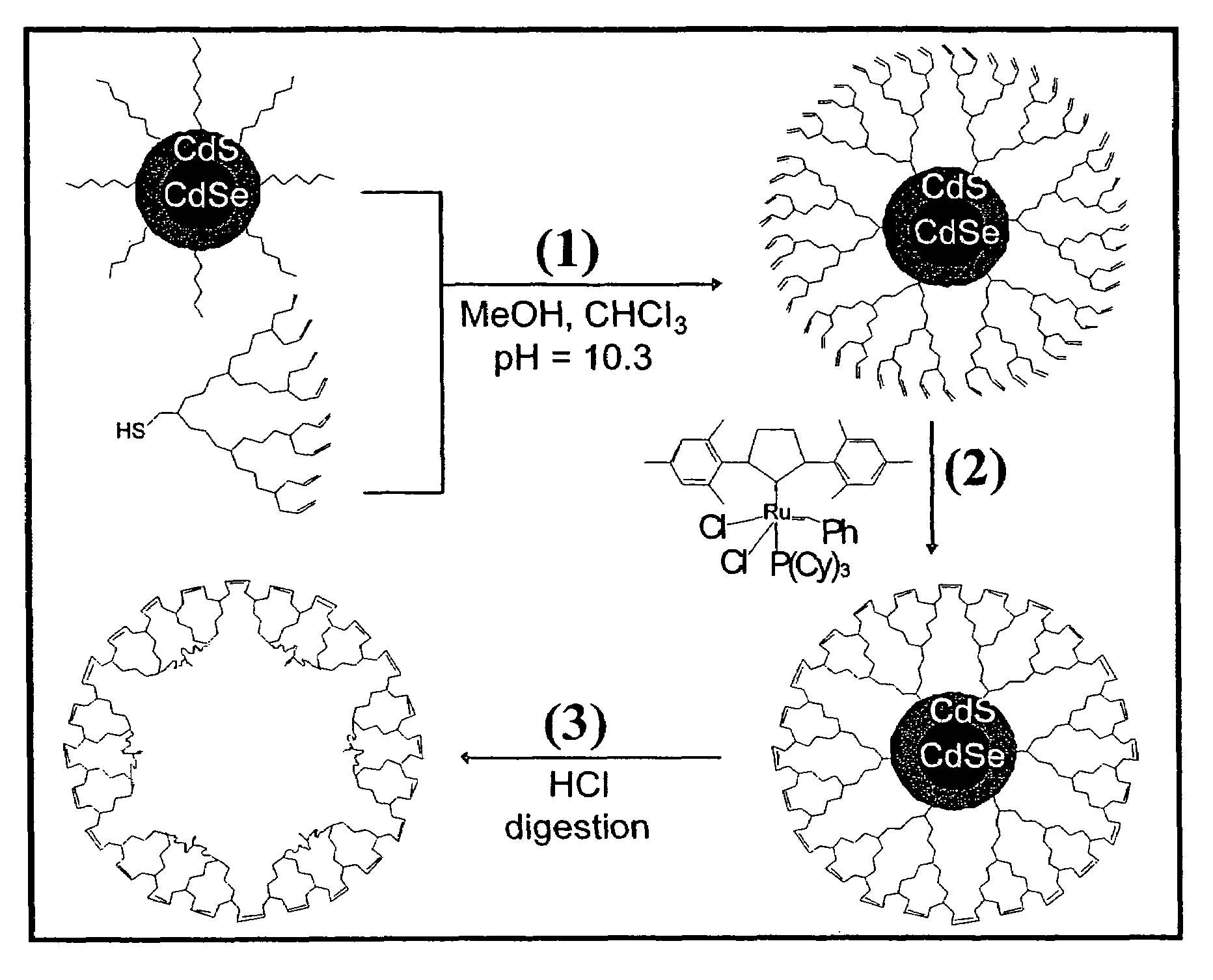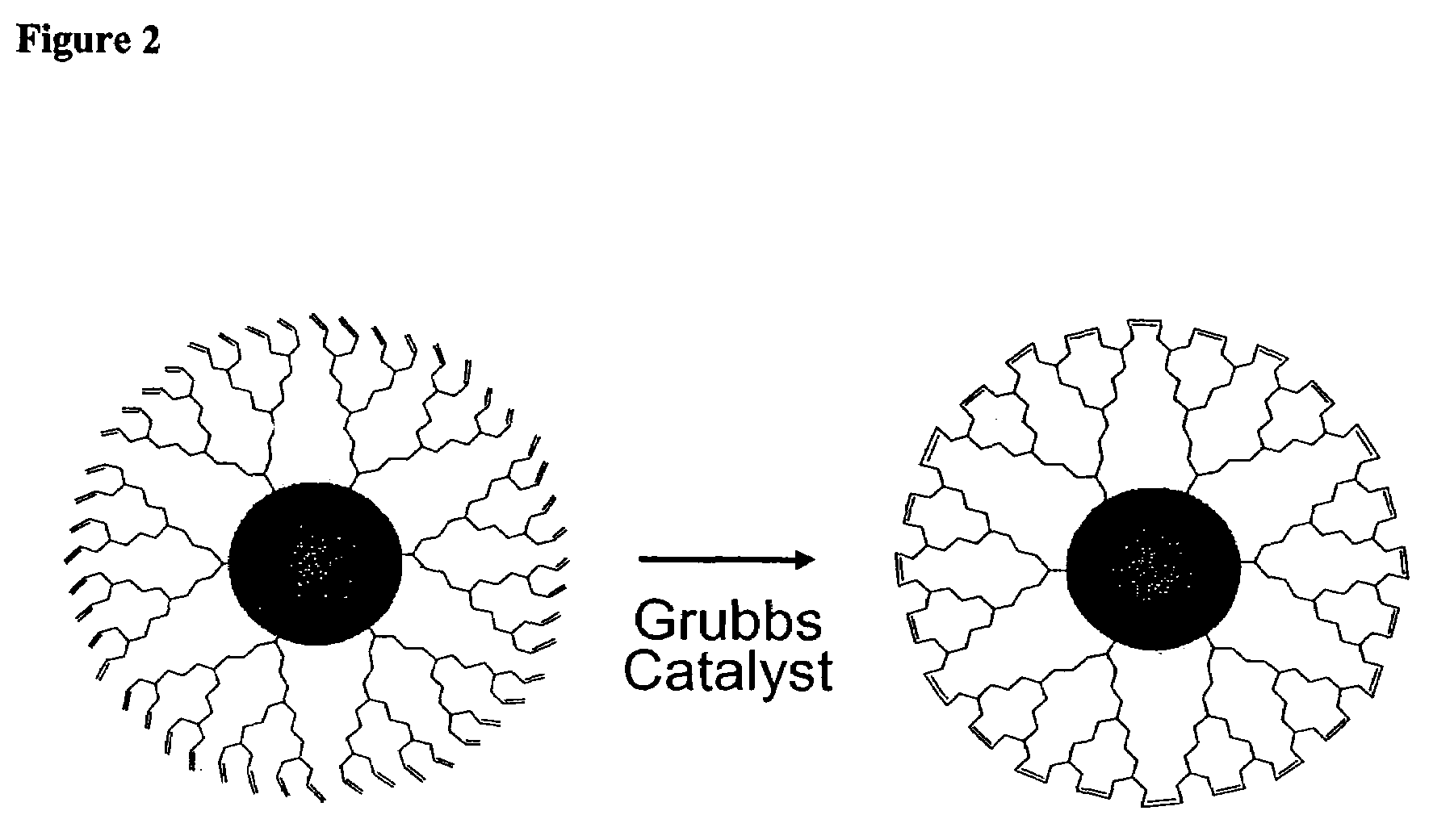Nanocrystals in ligand boxes exhibiting enhanced chemical, photochemical, and thermal stability, and methods of making the same
a technology of ligand boxes and nanocrystals, which is applied in the field of nanocrystals in ligand boxes exhibiting enhanced chemical, photochemical, thermal stability, and methods of making the same, can solve the problems of limited ligand dynamics and structure of nanocrystals within monolayers, limited knowledge regarding the structure of inorganic nanocrystal surfaces, and inability to achieve long-term stability, etc., to achieve the effect of improving stability and enhancing stability
- Summary
- Abstract
- Description
- Claims
- Application Information
AI Technical Summary
Benefits of technology
Problems solved by technology
Method used
Image
Examples
example 1
General Synthesis of a Symmetric Generation 3 (G3) Dendron Ligand
[0111]A symmetric G3 dendron ligand 6 was synthesized as shown in FIG. 17. The reagents, conditions, and yields for the reactions shown in FIG. 17 are as follows: a=2-aminoethanethiol hydrochloride, TFA, 25° C., 30 min, 85%; b=1 M NaOH, 96%; c=N-(tert-butoxycarbonyl)aziridine, CH3CN, reflux 3 days, 67%; d=TFA, 30 min, 92%; e=1 M NaOH, 98%; f=THF, K2CO3, reflux, 12 hours, 62%; g=TFA, triethylsilane, 95%; h=ethyl acetate, 72%. The focal point of the dendron ligands, a thiol group, was the binding site to surface cadmium atoms of the nanocrystals. In the synthesis, a triphenylmethyl group was applied to protect the thiol group as shown. With this protection, dendron precursors were stable under both acidic and basic conditions. Compound 2, 2-tritysulfanyl-ethylamine was obtained upon the treatment of triphenylmethanol with 2-aminoethanethiol hydrochloride in trifluroacetic acid (TFA), followed by neutralization with aqueo...
example 2
Synthesis of 2-Tritylsulfanyl-ethylamine (2)
[0112]Triphenylmethanol (22.9 g, 88 mmol) was added to a solution of 2-aminoethanethiol hydrochloride in trifluroacetic acid (TFA, 40 mL). The resulting solution was stirred at room temperature for about 40 min. The TFA was then removed under reduced pressure and the residue was triturated with diethyl ether. The white precipitate that formed was filtered, partitioned with aqueous NaOH (40 mL, 1N), and extracted with ethyl acetate (3×50 mL). The combined organic layers were dried over Na2SO4. The product was obtained as a white solid after solvent evaporation (23.8 g, yield 85%). ESI-MS(m / z): 320 (M+H+). 1H NMR δD (CDCl3): 7.21˜7.43 (m, 15H, phenyl), 2.58 (t, 2H, SCH2), 2.32 (t, 2H, CH2N).
example 3
Synthesis of Bis-(2-amino-ethyl)-(2-tritylsulfanyl)-amine (3)
[0113]A CH3CN (135 mL) solution of compound 2 (9.3 g, 29 mmol) and N-(tert-butoxycarbonyl)aziridine (12.3 g, 87 mmol) was refluxed for 3 days. The solvent was then removed under reduced pressure and the residual oil was purified by silica gel column chromatography with CHCl3 as the eluent. This procedure provided 12.3 g of BOC-protected G1 dendron as light yellow solid. This solid was then treated with TFA, dried under reduced pressure, and partitioned with aqueous NaOH to give compound 3 as yellow oil (7.9 g, yield 68%). ESI-MS (m / z): 406 (M+H+). 1H NMR δD (CDCl3): 7.23˜7.44 (m, 15H, phenyl), 2.78 (t, 2H, SCH2), 2.60˜2.70 (m, 4H, CH2NH2), 2.27˜2.35 (m, 6H, CH2N).
PUM
| Property | Measurement | Unit |
|---|---|---|
| diameter | aaaaa | aaaaa |
| diameter | aaaaa | aaaaa |
| diameter | aaaaa | aaaaa |
Abstract
Description
Claims
Application Information
 Login to View More
Login to View More - R&D
- Intellectual Property
- Life Sciences
- Materials
- Tech Scout
- Unparalleled Data Quality
- Higher Quality Content
- 60% Fewer Hallucinations
Browse by: Latest US Patents, China's latest patents, Technical Efficacy Thesaurus, Application Domain, Technology Topic, Popular Technical Reports.
© 2025 PatSnap. All rights reserved.Legal|Privacy policy|Modern Slavery Act Transparency Statement|Sitemap|About US| Contact US: help@patsnap.com



